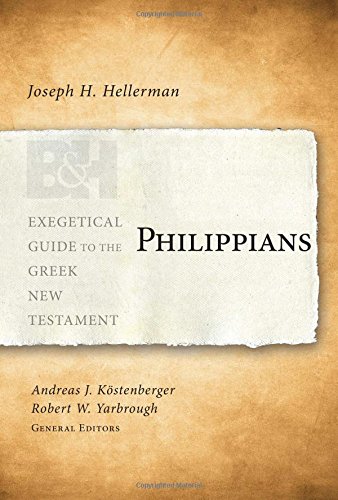 Philippians (Exegetical Guide to the Greek New Testament), by Joseph Hellerman (B&H Academic, 2015), 297.
Philippians (Exegetical Guide to the Greek New Testament), by Joseph Hellerman (B&H Academic, 2015), 297.
This handbook on the Greek text of Philippians is part of B&H Academic’s EGGNT series, several volumes of which we have reviewed. Each volume is aimed at intermediate Greek readers and focuses on syntax, vocabulary, and grammar. But each volume is also slightly distinctive, given an author’s chosen emphases.
Hellerman begins with a brief commentary introduction, concluding that Paul wrote the letter from Rome. He writes one long paragraph on aspect and Aktionsart, taking a position more aligned with Fanning than Porter, that aspect is the unaffected meaning and a correct translation must consider lexical, grammatical, or other contextual features. He concludes that he will be concerned with Aktionsart throughout the commentary.
But I think this notion that Aktionsart is the final outcome of “aspect + other features” may be a bit off target. This view, which was argued at length in Fanning’s monograph and has also been explained very clearly (and visually) by Constantine Campbell in his Basics of Verbal Aspect in Biblical Greek, is a popular way to treat aspect. Verbal aspect is the subjective representation of an event, while Aktionsart is the kind of action as it actually occurred (objectively). Fanning and Campbell essentially erode aspect into Aktionsart making it completely subservient to the latter. But aspect is a significant communicative device in many languages, even in English, which allows one to subjectively present an event in a certain way, regardless of the way it “actually” happened.
To give one English example, consider the following (and English encodes less aspect in its verbal structure than Greek). Japan attacked Pearl Harbor on December 7, 1941, and later attacked a U.S. oil field with a submarine on February 23, 1942. So objectively, there were two attacks. But we can speak of these attacks in multiple ways. (Roughly) perfective aspect: “Japan attacked us in World War I.” (Roughly) imperfective aspect: “In 1941-1942, Japan was attacking us.” (Roughly) stative aspect: “We were under attack in 1941-42.” Our verbal system allows us to use rough aspectual equivalents to subjectively present events for certain rhetorical effects. In Greek, if we collapse aspect into Aktionsart, as Hellerman does in this work, we would lose the subtleties of the biblical authors as they seek to represent object events with subjective aspectual features that give the desired rhetorical effect. I mention all of this because it plays into how Hellerman treats every verb in Philippians, and so is a significant point in assessing his work.
When assessing the book as a whole, the result is more similar to Harris’ Colossians & Philemon than to Forbes’ 1 Peter with regard to depth of analysis (Harris’ being far more in-depth and useful). Some good examples are the following:
- For the meaning of σωτηρίαν, he gives three positions, with six reasons for the first, four for the second, and three for the third, and a final paragraph with his reasons for choosing the third (58-59).
- When analyzing σώματί in Phil 1:20, he cites BDAG, NIDNTT, TDNT, H-M, Fee, Gundry, and Silva. This brief word study (only one paragraph) is deceptively packed with research (64).
- On the difficult phrase “have this mind among you, ὃ καὶ ἐν Χριστῷ Ἰησοῦ (Phil 2:5), he cites the two main positions, whether the ἐν expresses union with Christ that is the grounds for the Philippians having Christ’s mindset, or the location of the mindset as residing also in Christ (108-109). He provides five reasons for the first and two for the second, choosing the second in a small summarizing paragraph.
This sort of analysis is extremely helpful for pastors who need quick syntheses of arguments from the commentators and trustworthy judgment on these arguments. Students may also use Hellerman’s analysis as a model of careful attention to the Greek text.
Hellerman’s volume shares many of the other features that the EGGNT volumes have, including flow diagrams for each passage, suggestions for further reading by organized by topics that arise in each section, and brief comments about the literary makeup of each section after the flow. I still lament the inattention to wider discourse features of the NT books, which is not intended to be covered in these volumes, so one must supplement this lack with other works on discourse analysis, which you can find in our Annotated Bibliography, but especially the Philippians volume in the Semantic Structural Analysis from SIL.
As with the other EGGNT volumes, I commend this as an incredibly helpful resource for anyone preparing to preach or teach on Philippians.
An incredibly helpful resource for anyone preparing to preach or teach on Philippians Share on XCome back next time for an interview with Dr. Hellerman about his book.
Preview or buy it here in paperback or for Kindle. (Compare the prices, the Kindle edition is currently much cheaper.)


